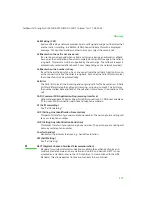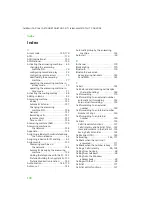
171
Glossary
talk&surf V.6 / englisch / A31008-X100-B100-1-76D1 / Glossar.fm / 17.09.2003
Call Waiting (CW)
Feature offered by a network provider. An acoustic signal during a call indicates that
another caller is waiting. In addition, ISDN phones indicate this with a displayed
message. You can then decide whether to accept or reject the second call.
Callback when the call is not answered
If a user does not respond when called, a caller can arrange an automatic callback.
As soon as the destination phone has completed a call and is free again the caller is
rung back. This service must be supported by the exchange. The callback request is
automatically cancelled after about 2 hours (depending on the network provider).
Callback when the number is busy
If a caller hears the busy tone, he or she can activate the callback function. As soon
as the connection is free the caller is rung back. As soon as the caller lifts his receiver
the connection is made automatically.
Calls list
The Calls list stores all the incoming and outgoing calls for the base station. A Calls
list filter differentiated the call types (incoming, outgoing, missed). The list stores
the number called, date and time of the call and, in some cases, the duration of the
call.
CAPI (Common ISDN Application Programming Interface)
Vendor-independent PC device driver for ISDN connections. A CAPI driver enables a
PC to use an ISDN connection with fax and telephone software.
CF (Call Forwarding)
See "Call forwarding"
CLIP (Calling Line Identification Presentation)
This permits transfer of your personal phone number. The person you are calling will
see your telephone number.
CLIR (Calling Line Identification Restriction)
This blocks transfer of your personal phone number. The person you are calling will
not see your telephone number.
Comfort handset
Handset with particular features, e. g. handsfree function.
CW (Call Waiting)
See "Call waiting"
D
DECT (Digital Enhanced Cordless Telecommunication)
Standard for wireless telecommunications enabling the exchange of voice and
multi-media data between a base station and up to 8 end devices. DECT is now
accepted as a standard in more than 70 countries. In conjunction with the GAP
Standard, this allows devices from various vendors to be combined.















































